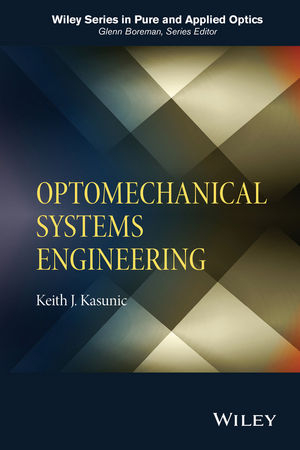
Optomechanical Systems Engineering
John Wiley & Sons Inc (Verlag)
978-1-118-80932-7 (ISBN)
Covers the fundamental principles behind optomechanical design
This book emphasizes a practical, systems-level overview of optomechanical engineering, showing throughout how the requirements on the optical system flow down to those on the optomechanical design. The author begins with an overview of optical engineering, including optical fundamentals as well as the fabrication and alignment of optical components such as lenses and mirrors. The concepts of optomechanical engineering are then applied to the design of optical systems, including the structural design of mechanical and optical components, structural dynamics, thermal design, and kinematic design.
Optomechanical Systems Engineering:
Reviews the fundamental concepts of optical engineering as they apply to optomechanical design
Illustrates the fabrication and alignment requirements typically found in an optical system
Examines the elements of structural design from a mechanical, optical, and vibrational viewpoint
Develops the thermal management principles of temperature and distortion control
Describes the optomechanical requirements for kinematic and semi-kinematic mounts
Uses examples and case studies to illustrate the concepts and equations presented in the book
Provides supplemental materials on a companion website
Focusing on fundamental concepts and first-order estimates of optomechanical system performance, Optomechanical Systems Engineering is accessible to engineers, scientists, and managers who want to quickly master the principles of optomechanical engineering.
Keith J. Kasunic has more than 25 years of experience developing optical, electro-optical, infrared, and laser systems. He holds a Ph.D. in Optical Sciences from the University of Arizona, an MS in Mechanical Engineering from Stanford University, and a BS in Mechanical Engineering from MIT. He is currently the Technical Director of Optical Systems Group LLC. He also teaches courses on optomechanical engineering as an SPIE Instructor, an Affiliate Instructor with Georgia Institute of Technology’s SENSIAC, an Instructor for the Optical Engineering Certificate Program at University of California–Irvine, and an Adjunct Professor at University of Central Florida’s CREOL.
Preface ix
1 Introduction 1
1.1 Optomechanical Systems, 2
1.2 Optomechanical Engineering, 4
1.3 Optomechanical Systems Engineering, 9
References, 15
2 Optical Fundamentals 17
2.1 Geometrical Optics, 18
2.2 Image Quality, 26
Problems, 33
References, 34
3 Optical Fabrication 35
3.1 Index of Refraction, 38
3.2 Surface Curvature, 41
3.3 Surface Figure, 43
3.4 Surface Finish, 48
3.5 Surface Quality, 49
3.6 Center Thickness, 50
3.7 Wedge, 51
3.8 Clear Aperture, 53
Problems, 54
References, 55
4 Optical Alignment 57
4.1 Types of Misalignments, 58
4.1.1 Tilt, 59
4.1.2 Decenter, 61
4.1.3 Despace, 62
4.1.4 Defocus, 62
4.2 Alignment Requirements, 64
4.3 Correction and Mitigation, 66
4.4 Pointing and Boresighting, 70
Problems, 75
References, 76
5 Structural Design—Mechanical Elements 77
5.1 Stress, Strain, and Stiffness, 78
5.2 Mechanics, 82
5.3 Beam Stresses and Strains, 85
5.3.1 Bending Stresses, 86
5.3.2 Bending Strain, 89
5.3.3 Shear Stresses and Strains, 94
5.4 Structural Geometries, 95
5.5 Structural Materials, 99
5.5.1 Specific Stiffness, 100
5.5.2 Microcreep, 102
5.5.3 Materials Selection, 103
Problems, 104
References, 105
6 Structural Design—Optical Components 107
6.1 Structural Plates, 109
6.1.1 Windows, Lenses, and Mirrors, 109
6.1.2 Poisson’s Ratio, 111
6.1.3 Plate Bending, 113
6.1.4 Contact Stresses, 115
6.1.5 Stress Concentrations, 120
6.2 Glass Strength, 122
6.2.1 Fracture Toughness, 122
6.2.2 Weibull Statistics, 126
Problems, 130
References, 131
7 Structural Design—Vibrations 133
7.1 Sinusoidal Vibrations, 137
7.1.1 Free Vibrations, 137
7.1.2 Forced Vibrations, 140
7.1.3 Damping, 142
7.2 Random Vibrations, 146
7.3 Continuous Systems, 150
7.4 Structural Design and Materials Selection, 157
7.5 Vibration Isolation, 159
7.6 Vibration Compensation, 166
Problems, 168
References, 169
8 Thermal Design 171
8.1 Thermostructural Design, 173
8.1.1 Thermal Expansion, 173
8.1.2 Thermal Stress, 178
8.2 Thermo‐Optic and Stress‐Optic Effects, 181
8.2.1 Thermo‐Optic Effect, 182
8.2.2 Stress‐Optic Effect, 185
8.3 Heat Transfer, 187
8.3.1 Conduction, 187
8.3.2 Convection, 193
8.3.3 Radiation, 196
8.4 Thermal Management, 201
8.4.1 Heaters, 202
8.4.2 Fans, 203
8.4.3 Thermal Interface Materials (TIMs), 203
8.4.4 Thermoelectric Coolers (TECs), 204
8.5 Material Properties and Selection, 205
8.5.1 Thermal Expansion, 206
8.5.2 Thermal Distortion, 207
8.5.3 Thermal Mass, 208
8.5.4 Thermal Diffusivity, 209
8.5.5 Thermal Shock, 210
Problems, 211
References, 212
9 Kinematic Design 215
9.1 Kinematic and Semi‐Kinematic Mounts, 216
9.2 Optical Component Mounts, 222
9.3 Positioning and Alignment Mechanisms, 227
9.4 Material Properties and Selection, 233
Problems, 235
References, 235
10 System Design 237
10.1 STOP Analysis, 239
10.2 WFE and Zernike Polynomials, 243
10.3 Material Trades, 246
References, 250
Index 251
| Erscheint lt. Verlag | 29.5.2015 |
|---|---|
| Reihe/Serie | Wiley Series in Pure and Applied Optics |
| Verlagsort | New York |
| Sprache | englisch |
| Maße | 158 x 231 mm |
| Gewicht | 544 g |
| Themenwelt | Naturwissenschaften ► Physik / Astronomie ► Optik |
| Technik ► Maschinenbau | |
| ISBN-10 | 1-118-80932-7 / 1118809327 |
| ISBN-13 | 978-1-118-80932-7 / 9781118809327 |
| Zustand | Neuware |
| Informationen gemäß Produktsicherheitsverordnung (GPSR) | |
| Haben Sie eine Frage zum Produkt? |
aus dem Bereich


